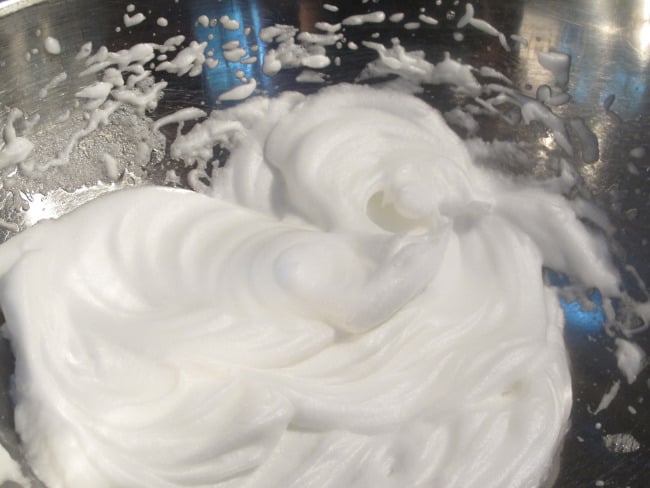Now I know all about whipping egg whites, even pasteurized ones.

I learned the hard way, but you don’t have to if you read on.
When my brother and I were kids, he was in a gymnastics show at school. He performed with great finesse, much to the amusement and pride of our dad. After the performance, Dad said to my brother “I didn’t know you could stand on your head. Why didn’t you tell me you could do all that wonderful stuff?” Without skipping a beat, my brother replied, “You never asked.”

And so it was this weekend. I never thought to ask – or to research – how to whip egg whites. Now that I’ve learned, I’ll let you in on several tips – and the results of my experiment.
This weekend, I decided to make chocolate mousse for a dinner with friends. After shifting through numerous recipes, I settled on Dorie Greenspan’s version. She calls for raw eggs. After separating the eggs and melting the chocolate, Dorie adds the raw yolks to the melted chocolate. Then she whips up the whites and adds them to the chocolate mixture. Simple and delicious, I thought. But using “ordinary” eggs raw does present a small risk of salmonella. How to avoid that risk and still use raw eggs in the mousse?
Use pasteurized eggs. Sold in grocery stores next to other cartons of raw eggs, they go through a pasteurization process that uses heat (in a water bath) to kill bacteria without cooking the egg.
Being a smarty-pants, I bought pasteurized eggs and started to make the mousse. I followed my usual tips for whipping egg whites.
- Use a clean bowl and beaters (because grease will inhibit the whipping);
- Before whipping them, bring the eggs to room temperature by submerging them in a bowl of warm water for a few minutes;
- Carefully separate the yolks and whites, so that no bits of yolk or shell get into the whites; and
- Start whipping at the lowest speed and gradually increase the mixer speed.
Although this trick is not my standard egg-separating method, it is fun.
After 20 minutes, all I had was a foamy glob. Where were the beautiful, whipped peaks and what could be done about this terrible moment in my dessert-making life? Could my mousse be saved? Sort of. I added the foamed-but-not-well-whipped egg whites, included a small amount of whipped cream and served the mousse with more, Grand Marnier-flavored, whipped cream. Not bad, but definitely not the light and luxurious texture I had envisioned.
What was the problem? It turns out that pasteurization “tightens” the egg white or albumen. In order to loosen it and get the whites to whip properly, you need to add a tad of cream of tartar or fresh lemon juice after the whites get foamy, about 1 minute into the whipping process.
Although I did find this answer easily by googling my question, like my Dad, I had no idea that I should have been asking questions beforehand.
My research uncovered contradictory advice on how much cream of tartar to use. Rose Levy Beranbaum, one of my favorite baking authorities, insists on ¼ teaspoon of cream of tartar for each pasteurized egg white (but only ⅛ teaspoon for each “regular” egg white.) On the other hand, a company that sells pasteurized eggs specifies ⅛ teaspoon for each pasteurized egg.
With my inquiring mind, but without America’s Test Kitchen budget or staff, I tried both methods. Then I compared the results to a pasteurized egg white and an ordinary egg white, each whipped without any cream of tartar.
My Egg White Whipping Experiment
Of the pasteurized whites, Levy Berenbaum’s ¼ teaspoon cream of tartar per pasteurized egg white yielded the best consistency and whipped up nicely in about 6½ minutes.
The egg processor (Davidson’s Safest Choice) ⅛ teaspoon method worked reasonably, but took longer (8 minutes) and the peaks weren’t quite as nice.
As was my experience over the weekend, the pasteurized egg white without cream of tartar was a “no go.” After 8 minutes, the egg white was foamy and a bit stiff, but not with peaks and it lacked the shine of a properly whipped egg white.
The ordinary egg whipped up just fine without cream of tartar in 4 minutes.
What does one do with the results of an experiment like this? Make meringues of course.







Suze says
Thank you so much for this information! I have been trying to figure out how to whip pasteurized egg whites. But maybe, even more than the info, I love your outfit and haircut as a child! It looks just like me and my sisters when we were that age – VERY similar outfits and haircuts! So cute!
Laura says
Suze, Glad you found the article helpful – and yes, that haircut and outfit were typical of the era:)
Carla says
Thank you – you just saved my mousse!
Laura says
Carla, Glad I helped.
Lauren says
So grateful for this – thank you!!
Laura says
Lauren, Delighted to help. Hope you’ll stop by again soon.
Barbara E Qualls says
Thanks for adding to my kitchen science knowledge!
Amy says
Thanks so much for figuring this out. I had a discouraging day making angel food cake with cartons of egg whites. 2 batches of soupy whippings down the drain! The 3rd attempt I gave up, added the flour and baked the cake anyway. It was sticky but still good. Sire wish I had come across your blog earlier Lol.
Laura says
Amy – Ugh! So sorry you had such discouraging experiences with egg whites recently. Hopefully it will never happen to you again, now that you’ve got a few tips for your egg white whipping.